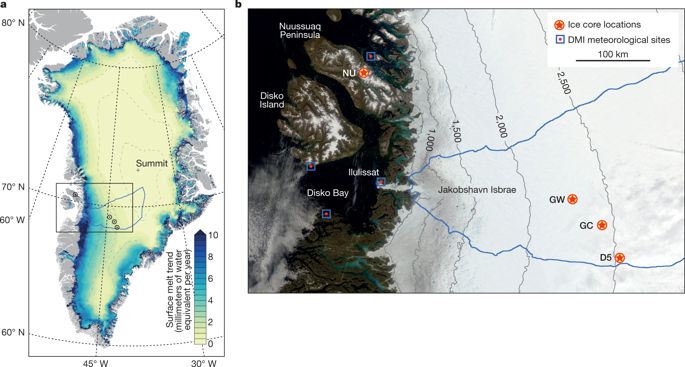Our official English website, www.x-mol.net, welcomes your feedback! (Note: you will need to create a separate account there.)
Nonlinear rise in Greenland runoff in response to post-industrial Arctic warming
Nature ( IF 64.8 ) Pub Date : 2018-12-01 , DOI: 10.1038/s41586-018-0752-4 Luke D. Trusel , Sarah B. Das , Matthew B. Osman , Matthew J. Evans , Ben E. Smith , Xavier Fettweis , Joseph R. McConnell , Brice P. Y. Noël , Michiel R. van den Broeke
Nature ( IF 64.8 ) Pub Date : 2018-12-01 , DOI: 10.1038/s41586-018-0752-4 Luke D. Trusel , Sarah B. Das , Matthew B. Osman , Matthew J. Evans , Ben E. Smith , Xavier Fettweis , Joseph R. McConnell , Brice P. Y. Noël , Michiel R. van den Broeke

|
The Greenland ice sheet (GrIS) is a growing contributor to global sea-level rise1, with recent ice mass loss dominated by surface meltwater runoff2,3. Satellite observations reveal positive trends in GrIS surface melt extent4, but melt variability, intensity and runoff remain uncertain before the satellite era. Here we present the first continuous, multi-century and observationally constrained record of GrIS surface melt intensity and runoff, revealing that the magnitude of recent GrIS melting is exceptional over at least the last 350 years. We develop this record through stratigraphic analysis of central west Greenland ice cores, and demonstrate that measurements of refrozen melt layers in percolation zone ice cores can be used to quantifiably, and reproducibly, reconstruct past melt rates. We show significant (P < 0.01) and spatially extensive correlations between these ice-core-derived melt records and modelled melt rates5,6 and satellite-derived melt duration4 across Greenland more broadly, enabling the reconstruction of past ice-sheet-scale surface melt intensity and runoff. We find that the initiation of increases in GrIS melting closely follow the onset of industrial-era Arctic warming in the mid-1800s, but that the magnitude of GrIS melting has only recently emerged beyond the range of natural variability. Owing to a nonlinear response of surface melting to increasing summer air temperatures, continued atmospheric warming will lead to rapid increases in GrIS runoff and sea-level contributions.Ice-core-derived melt records reveal that atmospheric warming has recently intensified Greenland ice-sheet surface melt and runoff to levels that are exceptional over at least the last 350 years.
中文翻译:

响应后工业化北极变暖,格陵兰岛径流非线性上升
格陵兰冰盖 (GrIS) 对全球海平面上升的贡献越来越大 1,最近的冰块损失主要由地表融水径流 2,3 决定。卫星观测揭示了 GrIS 地表融化范围 4 的积极趋势,但在卫星时代之前,融化变化、强度和径流仍然不确定。在这里,我们展示了 GrIS 地表融化强度和径流的第一个连续、多世纪和观测约束记录,揭示了最近的 GrIS 融化的幅度至少在过去 350 年中是异常的。我们通过对格陵兰岛中西部冰芯的地层分析开发了这一记录,并证明了对渗透区冰芯中再冻结融化层的测量可用于可量化和可重复地重建过去的融化速率。我们显示显着(P < 0。01) 以及这些冰核衍生的融化记录与建模的融化速率 5,6 和卫星衍生的融化持续时间 4 之间更广泛的空间广泛相关性,从而能够重建过去冰盖尺度的表面融化强度和径流。我们发现,随着 1800 年代中期工业时代北极变暖的开始,GRIS 融化的开始密切相关,但 GRIS 融化的幅度最近才出现超出自然变异的范围。由于地表融化对夏季气温升高的非线性响应,持续的大气变暖将导致 GrIS 径流和海平面贡献的迅速增加。
更新日期:2018-12-01
中文翻译:

响应后工业化北极变暖,格陵兰岛径流非线性上升
格陵兰冰盖 (GrIS) 对全球海平面上升的贡献越来越大 1,最近的冰块损失主要由地表融水径流 2,3 决定。卫星观测揭示了 GrIS 地表融化范围 4 的积极趋势,但在卫星时代之前,融化变化、强度和径流仍然不确定。在这里,我们展示了 GrIS 地表融化强度和径流的第一个连续、多世纪和观测约束记录,揭示了最近的 GrIS 融化的幅度至少在过去 350 年中是异常的。我们通过对格陵兰岛中西部冰芯的地层分析开发了这一记录,并证明了对渗透区冰芯中再冻结融化层的测量可用于可量化和可重复地重建过去的融化速率。我们显示显着(P < 0。01) 以及这些冰核衍生的融化记录与建模的融化速率 5,6 和卫星衍生的融化持续时间 4 之间更广泛的空间广泛相关性,从而能够重建过去冰盖尺度的表面融化强度和径流。我们发现,随着 1800 年代中期工业时代北极变暖的开始,GRIS 融化的开始密切相关,但 GRIS 融化的幅度最近才出现超出自然变异的范围。由于地表融化对夏季气温升高的非线性响应,持续的大气变暖将导致 GrIS 径流和海平面贡献的迅速增加。



























 京公网安备 11010802027423号
京公网安备 11010802027423号